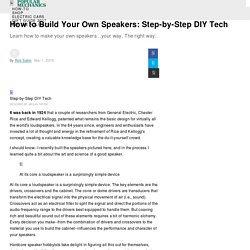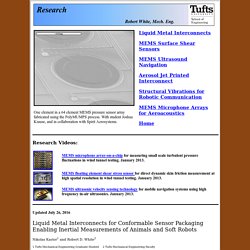

The Speakers With The Deepest Bass: Tactile Transducers. In A Nutshell The speakers that produce the lowest bass are tactile transducers — they typically produce frequencies in the 0.5 – 20 Hz range.

Tactile sound is not perceived through the ears — it perceived through the body. Most subwoofers are incapable of producing audio in this range. A good tactile transducer to start with is $150, entry-level Clark Synthesis Silver Edition (TST239) — it provides ample sub-frequency bass for the home user. The Details Tactile sound is the sensation of sound transmitted directly to the human body by contact, rather than by sound waves through the ears (tympanic sensation). More specifically, it is sound perceived through bone conduction, through muscles and deep tissue, and via skin sensation. What are the techniques engineers use to get deep bass out of a speaker driver? - Quora. How to Make Your Own Speakers Easily. Designed by Megan Tatem Advertisement - Continue Reading Below It was back in 1924 that a couple of researchers from General Electric, Chester Rice and Edward Kellogg, patented what remains the basic design for virtually all the world's loudspeakers.

In the 84 years since, engineers and enthusiasts have invested a lot of thought and energy in the refinement of Rice and Kellogg's concept, creating a valuable knowledge base for the do-it-yourself crowd. I should know--I recently built the speakers pictured here, and in the process I learned quite a bit about the art and science of a good speaker. At its core a loudspeaker is a surprisingly simple device At its core a loudspeaker is a surprisingly simple device. B&O Tech: How to Make a Loudspeaker Driver (A primer) – earfluff and eyecandy. #11 in a series of articles about the technology behind Bang & Olufsen loudspeakers I realised this week that I’ve been throwing around words like ” voice coil”, “suspension”, “surround” and “spider” when I talk about loudspeakers, but many people don’t know what these things are – or how a loudspeaker driver works in general… So, this week, I thought I might back up a couple of steps and talk about some basics.

There’s nothing here about Bang & Olufsen loudspeakers specifically – it’s just an introduction to how loudspeaker drivers (like woofers, for example) work. Back in 1820, a Danish guy named Hans Christian Ørsted was in the middle of giving a lecture when he noticed that, when he switched a circuit on and off, a compass sitting nearby on the desk moved a little. Nowadays, we know that, by putting current through a wire, you produce a magnetic field that has magnetic lines of force that encircle the wire. So, let’s do something weird. Acoustic imaging with outline detection. Reverberated sound can make objects visible.

The sonar is used in the shipping industry to acquire information about the seabed or shoals of fish, while gynaecologists use ultrasound images to study foetuses in the womb. Material testing procedures that regularly check for fissures in rail tracks or aircraft support structures are also based on ultrasound. Researchers at ETH Zurich have now developed a new type of acoustic imaging device which, rather than producing a photorealistic image of an entire object, shows only its contours and edges.
“This type of measuring method delivers similar results to the edge detection filter in an image-processing software, which allows the outline of prominent photo objects to be identified with the click of the mouse,” explains Chiara Daraio, Professor of Mechanics and Materials. Her method, however, is not software-based. Robert White, Tufts University. Liquid Metal Interconnects for Conformable Sensor Packaging Enabling Inertial Measurements of Animals and Soft Robots Nikolas Kastor1 and Robert D.

White2 1 Tufts Mechanical Engineering Graduate Student 2 Tufts Mechanical Engineering Faculty. Microphone arrays to unlock the potential of speech recognition. Dag Kittlaus, CEO of Viv Labs (viv.ai), has recently given some impressive demonstrations of his latest AI technologies, but one thing that always looks odd during the Viv demonstrations is that he holds the phone very close to his mouth.

He’s almost eating his phone every time – it’s like something from Trigger Happy TV. Dag needs to make sure that the quality of captured speech is clear enough for the software to decipher the content of the commands, but it’s not a real-world scenario. We’re not all going to want to "eat" our phones in order to book an airfare for next week. Voice interfaces are sometimes called conversational interfaces for good reason - they allow users to talk to the device instead of using touch screens and buttons to execute a command.
Conversations take place between two or more people who may be next to each other but are often a couple or more meters apart. Microphone arrays. Ultrasonicmobile. LOUD: Large acOUstic Data Array Project. A 1020-Node microphone array and beamformer at the MIT Computer Science and Artificial Intelligence Laboratory.

Data Please see the data page for experimental data collected with the array. Purpose Ubiquitous computing environments are characterized by an unbounded amount of noise and crosstalk. In these environments, traditional methods of sound capture are insufficient, and array microphones are needed in order to obtain a clean recording of desired speech. The LOUD modular microphone array currently consists of 1020 microphones.